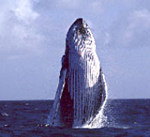 |
 |
 |
 |
 |
 |
 |
Humpback Whale Migration Update: March 15, 2000
Today's Report Includes:
- Greetings from the Stellwagen Bank National Marine Sanctuary
- Anne's Job Requires Lots of Training
- New Lingo! What is "GIS"?
- Humpback Mothers and Calves Yet to be Seen
- One-Way Trip: Challenge Question #6
- Why Keep Track?: Discussion of Challenge Question #4
- Singing Whales- What are They Trying to Tell Us? Discussion of CQ #5
- How to Respond to Today's Challenge Question
Greetings from the Stellwagen Bank National Marine Sanctuary
I'm Anne Smrcina, the education coordinator of the sanctuary and your humpback whale correspondent. I'll be contacting a variety of scientists and naturalists and government officials over the next few months to give you the latest updates on humpback whale migrations and status of the population.
Anne's Job Requires Lots of Training!
I spent all of last week in California (at a national marine sanctuary program planning meeting for the national education plan) and then got sent to Charleston, SC this week for GIS training.
New Lingo! What is "GIS"?
One of the big new buzz words in computer lingo today is "GIS". Good luck saying it! It sounds like something a mad snake might spit out! Anyway, GIS stands for Geographic Information System. These systems are used by computers to help us take a lot of information, like data on where the whales have been spotted, and put that information onto a map! GIS is a cool tool we can use to study "wha's happenin'" (I mean, 'what's happening') in our world. Journey North uses GIS software to help us make maps to show you where all of the animals are being sighted as they make their migrations each season.
Humpback Mothers and Calves Yet to be Seen
 |
One-Way Trip: Challenge Question #6:
"If they follow the coast line, how far do the humpbacks travel (in miles and kilometers) from the Silver Bank Sanctuary to the Stellwagen Bank Sanctuary?"
(To respond to this question,
please follow the instructions below.)
Why Keep Track?: Discussion of Challenge Question #4
Last time Anne Smrcina asked us why a US Federal agency is interested in keeping track of the whales in the waters off of Venezuela?
Some of you out there are really doing your homework! Iselin Middle School writes:
"The federal agency in charge of the endangered species conversation protection wants to know about the number of humpback whales in waters outside of the United States because they are interested in developing a better estimate of the number of humpbacks in the world. This helps to verify the number each year and tells scientists whether they are increasing or decreasing due to mating, disease, or any other environmental problems."
Thanks for your carefully thought out answer, Brigot and Steven from Iselin Middle School! (iselin5@injersey.infi.net)
Singing Whales- What are They Trying to Tell Us?
Discussion of CQ #
The males (and only the males) in the warm breeding waters are famous for their songs - long series of vocalizations that can last for up to 30 minutes. We asked why the whales sing, and you came up with some great answers.
 |
We think humpback whales sing to attract female whales, to get their attention and showoff around them...they're trying to communicate with the girls. As Peter says, "They're probably yelling, "I'm a bachelor, come with me!""
Mrs. Howley's Class, Grade 5, Pemetic Elementary School, Southwest Harbor, Maine, Especially Abby, Wes, and Peter
Anne answered it this way: "Perhaps they are intended to let other animals know where they are and who they are. The songs don't seem to be way of attracting partners, as most females seem to avoid the singers. The whales that sing on the breeding grounds seem to have the same song, although there may be some small variations. As the season progresses, the songs change too. There is still very much about these whales that we know so little about (and opportunities for all of you future field biologists).
That's all for this report. This is Anne Smrcina, education coordinator for the Stellwagen Bank National Marine Sanctuary, signing off. I'll be filing my next report on March 29.
How to Respond to Today's Challenge Question:
1. Address an e-mail message to: jn-challenge-hwhale@learner.org
2. In the Subject Line of your message write: Challenge Question #6
3. In the body of your message, answer the question above.
The Next Humpback Whale Migration Update will Be Posted on March 29, 2000
Copyright 2000 Journey North. All Rights Reserved. Please send all questions, comments, and suggestions to our feedback form
 |
 |
 |
 |
 |
 |
